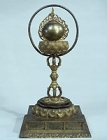Japanese Gallery (Honkan) Room 14
June 2, 2009 (Tue) - August 23, 2009 (Sun)
Esoteric Buddhism, brought to Japan by figures such as Kukai and Saicho at the beginning of the Heian period (794-1192), made use of unique ritual objects. These were distinctly different from the ritual implements which had prevailed under the Buddhist tradition practiced during the Nara period (710-794) and earlier.
Ritual objects represent an important subgroup of Esoteric Buddhist decorative arts, and many outstanding examples were produced in line with the rise of Esoteric Buddhism during the Heian and Kamakura (1192-1333) periods. Ritual prayer is central to Esoteric practice, and the implements employed during these rites were believed to be invested with miraculous powers due to their mysterious shapes.
The majority of Esoteric Buddhist ritual objects are thought to have evolved from the weapons of ancient India, and examples such as gilt-bronze vajra and cakra wheels feature sharp prongs and blades which symbolize the banishment of worldly desires. Ritual bells, on the other hand, were believed to delight Buddhist deities with their sound, and awaken the potential for Buddhahood which was believed to be dormant in every individual.
Performed in dimly lit temple halls and incorporating such unusually shaped objects, the deep sense of mysticism embodied by Esoteric Buddhist rituals must have captivated people of long ago.

